I noticed this page became a bit of a hodge-podge - notes about places I ate at, food I cooked at home and my own thoughts and reflections on being veggie abroad. After reading through the posts I realized everything was completely all over the place and I wanted something more stream lined. So, I've decided to reorganize this section. Hopefully it'll be a bit more interesting and useful after I have revamped it.
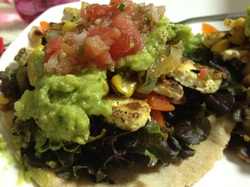
I've never been a big fan of Mexican food but every once in awhile I get a bit bored with my usual repertoire of recipes and try to make something new and interesting. I realized awhile back that rothi (whole wheat flat bread) would make a great substitution for tortilla. With the purchase of the occasional avocado sold in the local market and a bag of fresh cilantro I decided to make a soft veggie taco.
I made up fresh guacamole and salsa, grilled tofu and combined them with lettuce, bell peppers and cooked onions and corn atop rothi to get a tasty, filling and somewhat messy dinner. The next day I took the leftovers as a sort of "taco" salad.
Just about everyone who says it's easy to be a strict vegetarian (avoiding all meat, fish, etc) in Korea either 1) never eats out, 2) unknowingly eats a lot of meat products when he goes out to eat (kimchi isn't vegetarian, neither is ddeokboki or most juks) or 3) (which is most likely) lives in or around Seoul. Being a vegetarian in Korea is limiting no matter what, especially when you want to go out to eat with friends but you have a lot more options in Seoul.
Seoul is a major city with a population over 10 million people. It has a variety of ethnic restaurants which even if not Indian you have a good chance of finding at least one vegetarian entree (or one that could be easily adapted). It also has a variety of vegan restaurants - my preferred restaurant of choice when I go out to eat because there's no chance of fish in any form in the food. Frequently these vegan restaurants are associated with Buddhism - either directly connected to a temple or Buddhist organization or started by a former monk.
On my most recent trip to Seoul I got to eat at two tasty vegan restaurants - the chain restaurant Loving Hut and a smaller more intimate restaurant Oh Se Gae Hyang, which was opened by a former monk. Both restaurants offered up contemporary Korean dishes that have absolutely no animal products in them.
I completely overindulged while at these restaurants (probably not smart to eat at both on the same day) and got my fill of delicious (but sodium-laden) Korean food. I was a bit surprised how both restaurants had a lot of faux meat in their dishes. Most of the fake meats weren't made to recreate the taste of meat but they did have the same texture. While I'd definitely visit both again since I enjoyed the food but I wouldn't make it a habit because I didn't find the food to be very healthy overall.
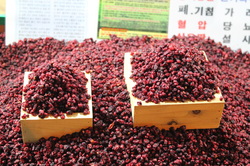
At the local cherry blossom festival I was excited to see that one of the vendors was selling omija - a berry for which this area is well known. I bought two scoops from the large wooden box for a mere 20,000won (less than $20) and took it home with plans to incorporate it into a dried pickle and chutney.
I made the chutney first based on a recipe I found online - chutney is a popular relish in India which uses fresh herbs, fruits and veggies. I had successfully made a tamarind chutney awhile back and had high hopes for the Korean/Indian style chutney. After soaking some of the berries in hot water I tasted them and to my surprise discovered that omija is rather bitter. Since the recipe called for a fair amount of sugar and the other dried fruits were incredibly sweet so I thought they'd balance it out. After spending hours standing over the stove stirring a gelatinous brown mess I let it cool and gave it a taste - there was a bit of a kick from the vinegar but overall it was tasty ... until I mistakenly bit into an omija seed. Blech - it had an awful bitter flavor which overpowered the rest of the chutney. I spent an hour picking out the seeds from half of the chutney before I froze it - I'll get to the rest when I have time.
The other omija inspired dish I made was a dried fruit pickle. This time I was wise enough to deseed the omija (a tedious project that took a good part of an hour) and I mixed it with other dried fruits, mustard oil, chili pepper and spices.
In addition to dried fruit pickle and dried fruit chutney I've also made refrigerator pickles, a spicy tomato pickle and mint chutney. I hope to make a lemon pickle soon and find a few other recipes to try out.
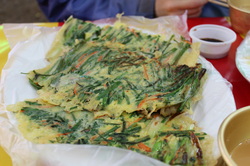
I found a new festival food in which I can partake and satisfies my desires for greasy food - jeon. This ubiquitous savory "pancake" is typically made with flour, water and julienned vegetables and served with a soy sauce concoction. Occasionally seafood like octopus is thrown into the batter but it's possible to request it without any. I was quite hungry when I sat down to enjoy this jeon therefore I was a bit disappointed when the woman working in the food tent decided that the guys at our table weren't eating enough - so she grabbed half of it with her chopsticks and plopped it down on a plate covered with pork grease. Naturally the guys weren't really hungry since they had just feasted on the pork which once sat atop that grease and I got to watch half of my jeon get wasted.
As you can see in the photos below festival food usually consists of a few things - namely meat, grease and/or sugar.
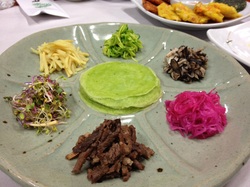
Early in March we had a dinner to welcome some of the new teachers to the Jeomchon area. We ate at a restaurant that I recommended based on having visited it with a co-worker in the fall. It was a lot easier to eat there as a vegetarian when you are with people who speak fluent Korean compared to a bunch of foreigners with varying degrees of Korean (some are quite good but not fluent). Though we asked for a few vegetarian dishes and explained that it shouldn't have meat - vegetarian dishes still contained fish and/or fish sauce. It's just a reminder that people have different perspectives on what constitutes meat. There still was a bit for us veggies to eat and the food was some of the most beautifully colored food I'd seen in a long time.
I realize that in the dullness of the winter I neglected to update not just my main blog but also this section. During my recent trip to India in late January/early February I was able to enjoy the ease of traveling around a country where vegetarianism is common and in some areas even the norm. Indian vegetarianism differs widely from that in Korea - no meat, including seafood nor eggs are in a vegetarian dish and this is commonly understand by everyone. I didn't need to pepper the waiter with questions or inspect my food suspiciously to determine if there was a misunderstanding and my entree had meat in it. Instead I was able to enjoy a wide variety of dishes and ate well for most of the time there (I did end up feeling ill for a couple of days after eating something that didn't agree with me).
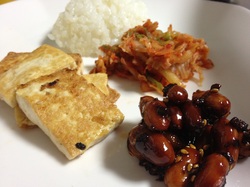
"Do you like kimchi?" is a common question posed to foreigners here in Korea and while my response is always "oh yes, it's very good" in my mind I'm usually thinking "meh." I'm not particularly fond of kimchi, it's not a dish I crave but I can't ignore its significance. Kimchi is pretty much synonymous with Korean food. When I ask my students what they eat for breakfast - kimchi and rice. For lunch? Kimchi, rice and soup. Supper? Kimchi, rice and meat. I doubt many of my students go a single day without eating kimchi at least once.
When my co-teacher's wife gave him a few heads of cabbage and some radish to pass on to me I decided to try my hand at kimchi. I rarely eat kimchi or any of the other popular side dishes because anchovies or oyster sauce are common ingredients. However, I've been doing some research on different types of banchan (side dishes) which I can make at home. Kimchi is a relatively simple recipe - it's a combination of pickled cabbage with radish and chili pepper. The recipe I used also called for green onions, garlic, ginger and Asian pear. The mixture is then stored in earthen-ware containers, typically buried in the ground during the winter months. This isn't quite possible at my apartment complex so I keep it sealed in an airtight container in the refrigerator. Kimchi is supposed to ferment for a few months in order to develop a bitter flavor but it can be eaten right away.
My own kimchi turned out ok, it's salty and a bit spicy, which seem to be requisites for the dish so I would say it is a success. In addition to the kimchi I also made a peanut side dish which is a mixture of boiled peanuts in a soy sauce/garlic/ginger syrup. I hope to improve upon the recipe in the future because I really enjoy this dish.
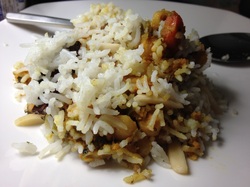
Jeomchon has limited international options and Seoul and Daegu are too far away to visit solely for dinner therefore I have had to expand my cooking repertoire here. I am slowly learning how to make a few different types of banchan (Korean side dishes), peanut chutney and a proper rothi (an Indian flatbread which though simple in recipe has been difficult for me to master the exact thickness of the dough). Earlier in December I decided to try my hand at Hyderbadi Vegetable Biryani. This Indian rice dish incorporates a lot of flavors including cumin, cloves, cinnamon and saffron with vegetables, dried fruits and nuts. The entire dish, from to start to finish took over two hours as I carefully roasted and ground the spices, cooked the rice and vegetable mixture separately and layered it all before steaming it on the stove. The final dish turned out well though I will tweak it if I ever make it again in the future.
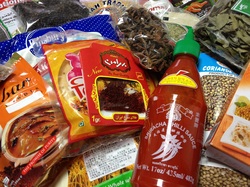
While I am still surprised at some of the food items I can find in Jeomchon it doesn't offer a lot of the ingredients I use on a regular basis. Therefore, when I visited Seoul recently one of my main stops was the international market in Itaewon. The small store offers a variety of international products but the majority of products are from the subcontinent. It has aisles of fresh spices, bags of lentils, rice and much more and so I was a bit overzealous while shopping with my list of over a dozen of items I hoped to find. I was thrilled to be able to locate most of what I was looking for including sambhar powder, atta, anise, tamarind, saffron, basmati rice and homemade yogurt. The total came out to approximately $100 which is reasonable considering almost everything I purchased was imported into Korea. It was at this store that I learned an interesting tid-bit and why I haven't been able to find long grain rice at any of the local stores - it is not permitted to import rice into Korea for sale. Therefore all long grained rice which is sold in stores is brought in by people traveling back and forth in suitcases which is why one kilogram of basmati rice costs between $10-20!